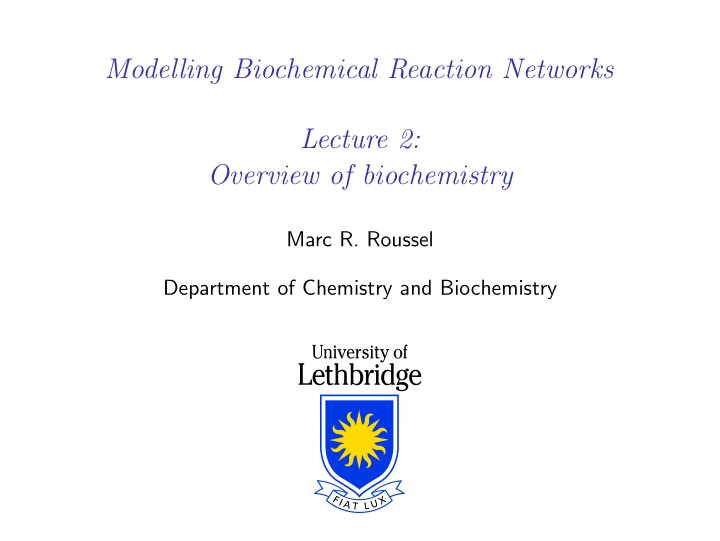



Modelling Biochemical Reaction Networks Lecture 2: Overview of biochemistry Marc R. Roussel Department of Chemistry and Biochemistry
Structure, function, and thermochemistry ◮ Molecular masses: 1 g / mol ≡ 1 amu ≡ 1 Da ◮ Living organisms contain molecules of all sizes, ranging from the very small (e.g. water, molecular mass 18 Da) to truly massive molecules (e.g. DNA, molecular masses in the GDa range). ◮ The functions and functioning of larger biomolecules are largely determined by their structures: ◮ Positioning of certain chemical groups ◮ Shape complementarity ◮ Mixture of molecular conformations (“structures”) is determined by thermochemistry: balance of energetic and entropic effects/decrease in free energy.
DNA ◮ Deoxyribonucleic acid (DNA) carries the genetic code of all cells and some viruses. ◮ A polymer of the four nucleotides adenine (A), thymine (T), guanine (G) and cytosine (C) ◮ Because of their shapes and of the complementarity of their chemical groups, the nucleotides can base pair through hydrogen bonds. Graphics: Isilanes, public domain images ( http://en.wikipedia.org/wiki/File:GC_DNA_base_pair.svg and http://en.wikipedia.org/wiki/File:AT_DNA_base_pair.svg )
DNA ◮ Most DNA found as a duplex (the famous double helix) in which each nucleotide is base-paired to the appropriate nucleotide in a complementary strand: Source: Madeleine Price Ball, Creative Commons license ( http://en.wikipedia.org/wiki/File:DNA_chemical_structure.svg )
RNA ◮ Ribonucleic acid (RNA) is a close cousin of DNA. ◮ A polymer of the four nucleotides guanine (G), cytosine (C), adenine (A) and uridine (U) ◮ RNA is transcribed from DNA using base pairing to direct the synthesis of a mirror image of the template: DNA G—RNA C DNA C—RNA G DNA A—RNA U DNA T—RNA A
RNA structure ◮ RNA is typically not found in double-stranded form. ◮ Base-pair complementation in different parts of an RNA molecule can lead to specific three-dimensional structures. Source: Yikrazuul, Creative Commons license ( http://en.wikipedia.org/wiki/File:TRNA-Phe_yeast_1ehz.png )
RNA functions Messenger RNA (mRNA): Carries genetic information from the nucleus to the ribosomes Ribosomal RNA (rRNA): Key parts (including all the catalytic functions) of ribosomes Transfer RNA (tRNA): Recognize complementary sequences on mRNA and carry amino acids for the synthesis of proteins in the ribosome Regulation: Some RNAs, including some very small ones, have regulatory roles, often by binding to complementary RNA or DNA sequences. RNA processing: Most of the machinery that processes RNAs after their transcription uses RNA parts. ◮ Splicing ◮ Modification of some nucleotides, e.g. of uridine to pseudouridine
Proteins ◮ Polymers of amino acids ◮ Function requires folding into specific structures, sometimes spontaneously, and sometimes with help ◮ Sometimes function in complexes either with other proteins of the same type or with different proteins, and sometimes with RNA ◮ Synthesized by ribosomes based on the instructions carried by mRNA in a process called translation ◮ May be modified post-translationally
Genetic code ◮ Ribosomes synthesize proteins from 20 amino acids. ◮ mRNA is read as a series of triplets known as codons. ◮ Need to encode 20 amino acids + start and stop ◮ The start codon is also used to encode one of the amino acids (methionine). ◮ There are three stop codons. ◮ 4 3 = 64 possible triplets, so the genetic code has some redundancy ◮ tRNAs have a particular region called an anticodon that is designed to base-pair with a complementary mRNA sequence in the ribosome. ◮ tRNAs are covalently bound to an amino acid, which is then available for protein synthesis.
Genetic code ◮ Base pairing of the third nucleotide in a codon-anticodon pair is somewhat sloppy, a feature exploited by the genetic code, so that fewer than 61 anticodons are required. ◮ Some examples: ◮ GUX encodes valine, regardless of the identity of X. ◮ GCX encodes alanine. � � U ◮ UU encode phenylalanine; C � � A UU and CUX encode leucine. G
Protein functions Enzymes: Biological catalysts (speed up reactions) Structural functions: e.g. actin and microtubules Molecular motors Signal detection and transduction: e.g. detection of hormones, modulation of transcription in response to signals Channels and pores Antibodies
Recommend
More recommend